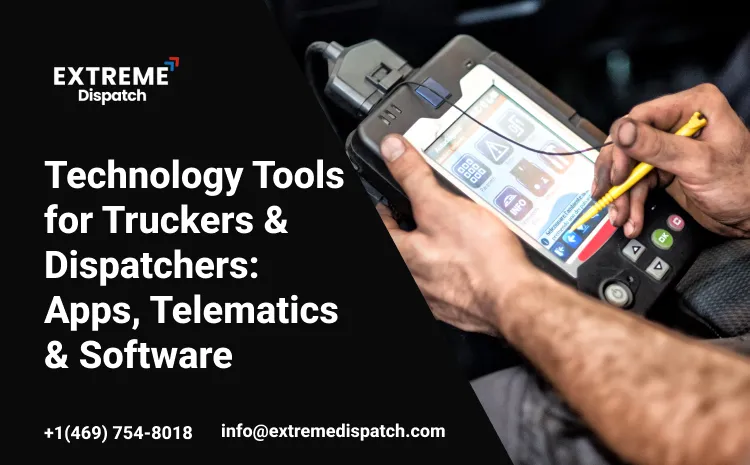In the fast-moving world of trucking, DOT compliance is one of the most critical responsibilities every carrier must understand. Whether you operate one truck or manage an entire fleet, compliance with Department of Transportation (DOT) and Federal Motor Carrier Safety Administration (FMCSA) regulations protects your business, drivers, and reputation.
This guide from Extreme Dispatch provides a complete understanding of DOT compliance, what it is, why it matters, the main areas to manage, and how to stay compliant in a rapidly evolving transportation landscape.

Keep Your Truck Moving – Get Consistent Loads Today
What Is DOT Compliance?
DOT compliance refers to the laws, standards, and reporting requirements established by the Department of Transportation and the FMCSA to ensure safe and lawful commercial vehicle operation. Carriers engaged in interstate commerce, passenger transport, or vehicles above the gross vehicle weight rating (GVWR) thresholds must comply with these regulations.
Compliance is more than just following the law; it ensures:
- Safety on the road for drivers and the public
- Operational efficiency through well-maintained vehicles and trained drivers
- Protection against penalties, fines, and loss of authority
- Trust from brokers, shippers, and clients
Ignoring compliance obligations can lead to financial losses, damaged reputation, or even the suspension of your MC number and operating authority.
Key Areas of DOT Compliance for Carriers
1. Driver Qualification and Documentation
Every carrier must maintain a Driver Qualification File (DQF) for each driver. This file verifies that drivers meet DOT standards and includes:
- Valid Commercial Driver’s License (CDL)
- Motor Vehicle Record (MVR) and driving history
- Employment application and background check
- DOT medical certification
- Records of training or remedial actions
Incomplete or outdated DQFs are among the most common violations. Carriers should regularly update these files and perform annual reviews to remain compliant.
2. Hours of Service (HOS) and Electronic Logging Devices (ELDs)
Hours of Service regulations prevent fatigue-related accidents by limiting driving and on-duty hours. The ELD mandate requires most carriers to use Electronic Logging Devices to record hours accurately.
Key HOS limits include:
- 11-hour driving limit per shift
- 14-hour on-duty window
- 60/70-hour weekly limits
Carriers must review logs regularly, correct violations promptly, and ensure that all drivers understand how to operate ELD systems correctly. Noncompliance in HOS management can quickly raise a carrier’s CSA (Compliance, Safety, Accountability) score.
3. Vehicle Maintenance and Inspection
Safe operations depend on consistent vehicle maintenance. DOT requires carriers to establish a formal maintenance program, which includes:
- Routine inspections and repairs
- Preventive maintenance schedules
- Documentation of all service and repair records
- Annual vehicle inspections conducted by certified inspectors
Drivers must also perform pre-trip and post-trip inspections daily and report any defects immediately. Poor maintenance or incomplete inspection reports can result in heavy fines or roadside out-of-service violations.
4. Drug and Alcohol Testing Compliance
Carriers must implement a drug and alcohol testing program to ensure driver fitness and road safety. Required testing includes:
- Pre-employment testing before a driver is hired
- Random testing throughout the year
- Post-accident and reasonable suspicion testing
- Return-to-duty testing after violations
All results must be reported to the FMCSA Drug and Alcohol Clearinghouse within three business days. Failing to maintain a compliant testing program can lead to serious penalties or suspension of operations.
5. Recordkeeping and Documentation
DOT compliance relies on accurate and organized documentation. Carriers must maintain records related to:
- Driver logs and HOS reports
- Vehicle maintenance and inspection records
- Driver qualification files
- Accident and incident reports
- Insurance certificates and permits
Records should be easily accessible during audits or inspections. Many successful carriers use digital compliance systems to centralize and secure their documents.
6. Safety Performance and CSA Monitoring
The FMCSA CSA program evaluates carriers based on categories like unsafe driving, maintenance, HOS compliance, and crash history. High CSA scores indicate frequent violations and may trigger audits or interventions.
Carriers can improve their CSA scores by:
- Enforcing driver safety training
- Correcting violations immediately
- Conducting internal audits
- Maintaining proper vehicle condition and documentation
7. DOT Audits and New Entrant Safety Assurance
New carriers typically undergo a New Entrant Safety Audit within the first 18 months of operation. This review ensures compliance systems are in place, including recordkeeping, driver files, maintenance programs, and drug testing procedures.
Failing an audit can result in fines or suspension of authority. Regular self-audits help identify weak points before official reviews occur.
Common DOT Compliance Mistakes
Many carriers unintentionally make mistakes that jeopardize their operations. Frequent violations include:
- Missing or outdated driver qualification files
- Hours-of-Service errors or missing ELD data
- Poor maintenance documentation
- Failing to report drug/alcohol violations
- Lack of recordkeeping for inspections or accidents
Each violation not only leads to fines but can also harm your CSA rating, limiting your ability to book loads or partner with reputable brokers.

Keep Your Truck Moving – Get Consistent Loads Today
Best Practices for Maintaining DOT Compliance
Staying compliant requires discipline, consistency, and proactive management. Below are proven strategies that top carriers follow, many of which align with Extreme Dispatch’s approach to compliance support.
1. Develop Clear Compliance Procedures
Create written Standard Operating Procedures (SOPs) for all compliance areas, from driver file creation to log reviews and maintenance tracking. Consistency reduces the risk of oversight.
2. Use a Compliance Calendar
Keep track of all important dates, such as vehicle inspections, medical renewals, permit expirations, and audit deadlines. A digital calendar helps prevent missed obligations.
3. Conduct Regular Internal Audits
Internal reviews help identify potential problems before regulators do. Check driver logs, vehicle files, and safety data regularly to maintain accuracy.
4. Leverage Technology
Implement compliance software, ELD monitoring systems, and fleet management tools. Automation reduces human error and keeps your compliance data current.
5. Train Your Team
Ensure both drivers and office staff understand compliance requirements. Regular training on HOS rules, inspection protocols, and safety practices builds accountability.
6. Partner With Compliance Experts
Many carriers choose to outsource DOT compliance management. Partnering with professionals like Extreme Dispatch ensures continuous oversight, documentation accuracy, and timely updates on regulation changes.
How Extreme Dispatch Supports DOT Compliance
Extreme Dispatch integrates compliance oversight into its full suite of dispatch and logistics services. Their dedicated Safety / DOT Compliance support helps carriers operate confidently and legally across the U.S.
Key Benefits Include:
- Management of driver qualification files and safety records
- Real-time HOS and ELD monitoring
- CSA score tracking and improvement strategies
- Documentation and audit preparation
- Ongoing compliance alerts and renewal reminders
Extreme Dispatch provides around-the-clock compliance support, allowing carriers to focus on freight while maintaining full regulatory alignment. Their team ensures every document, inspection, and report meets DOT and FMCSA requirements.
For growing carriers, Extreme Dispatch’s compliance solutions scale easily, helping fleets expand without losing control of their safety and documentation standards.
Final Thoughts
DOT compliance is not a one-time task, it’s an ongoing commitment to safety, accuracy, and responsibility. Every carrier, from single-truck operators to expanding fleets, must understand and manage compliance carefully to avoid penalties and ensure business longevity.
By combining knowledge, proactive systems, and expert support, carriers can stay ahead of regulations and build strong, trustworthy operations.
Partnering with Extreme Dispatch gives you that peace of mind. Their team ensures your paperwork, safety standards, and driver management meet every DOT requirement, so you can stay on the road and focus on what matters most: keeping your trucks moving and your business growing.
FAQs
1. What does DOT compliance mean for trucking companies?
DOT compliance refers to following the safety and operational regulations set by the Department of Transportation and FMCSA to ensure legal and safe commercial vehicle operations.
2. Why is DOT compliance important for carriers?
It helps carriers avoid fines, maintain safety standards, and ensure eligibility for partnerships with brokers and shippers.
3. What are the main areas of DOT compliance?
Key areas include driver qualification files, hours of service, vehicle maintenance, drug and alcohol testing, and recordkeeping.
4. How often does the DOT conduct audits?
Audits can occur anytime but are often triggered by accidents, safety violations, or random checks.
5. How can Extreme Dispatch help with DOT compliance?
Extreme Dispatch provides expert support to carriers by managing compliance documentation, safety monitoring, and ongoing regulatory updates to keep fleets audit-ready.

Subscribe to Learn more about Extreme Dispatch
By clicking “Subscribe” you agree to our Privacy Policy and consent to using your contact data for newsletter purposes


















